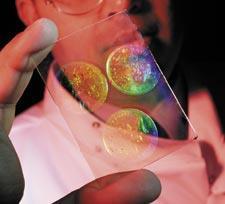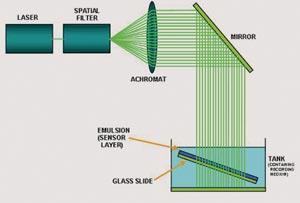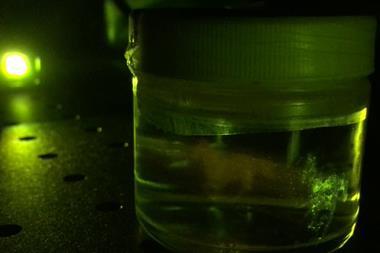Smart Holograms' novel sensors can monitor almost anything, from glucose to bacteria, as Emma Davies finds out.
Smart Holograms’ novel sensors can monitor almost anything, from glucose to bacteria, as Emma Davies finds out.
Frank Craig, Smart Hologram’s CEO, has been talking to so many potential investors that for several weeks his voice has been reduced to a whisper. He has been spreading the word about the company’s novel hologram technology to raise series B financing. Losing his voice ’goes with the territory’ and does little to dent his enthusiasm. The UK company has so far financed itself with money from venture capitalists, the government and corporate and academic partner contracts.
The Cambridge University spin-out was set up in 2002 to commercialise polymer-based sensor holograms. Smart has 30 granted or filed patents and three hologram product prototypes: a non-invasive sensor for continuous glucose monitoring for diabetics (glucoprobe); a portable sensor device for detecting microbial contamination (pathotester); and a sensor strip for detecting analytes.

The global finance hunt has brought interest in the hologram technology from all quarters. The sensors can be adapted to detect different stimuli, and Smart is open to suggestions for new applications. For example, discussions with a local architect provided an idea for large sensing surfaces in architectural structures such as skyscraper windows. Meanwhile, Chris Lowe, Smart co-founder and company director, has come up with the idea of using holograms in clothing. Craig jokes that Smart will end up with creative offices where ’fashionistas rub shoulders with scientists, engineers, financiers and architects’.
Even Playboy is rumoured to have expressed interest in the holograms, with an idea for a product with an image of a woman whose clothes would disappear when breathed on. Needless to say, this didn’t even reach the discussion stage.
Smart is currently building a pilot hologram manufacturing plant at its Cambridge site which will go on stream later this year, producing one million sensor holograms/week/system. Beyond this, the company has a variety of manufacturing options, including the possibility of setting up a dedicated manufacturing facility.
Smart is based in Cambridge, UK, but also has a commercial office in San Ramon, US. In the past year, the company has doubled its number of employees and tripled facility size, currently employing 25 in-house staff. It also has access to the intellectual property generated by Lowe and his group at Cambridge University.
Sweet solution
Craig and his colleagues are confident that Smart’s glucose sensors for diabetes self-testing will be the real money spinner, allowing them to tap into the medical devices and diagnostics market, estimated to be worth ?16 billion per annum.
The glucose sensors could take up to three years to get regulatory approval for the diabetes self-testing market. To fund the company through the intervening years, Smart is also focusing on its non-core business, says Craig. ’To make cash we have dipped into other industries.’
Deciding which markets to target has not been easy. As Satyamoorthy Kabilan, a principal scientist and co-founder at Smart, points out: ’Our biggest problem and advantage at the same time is the fact that we can go into so many markets. We need to juggle opportunity, lead time to market, and market size. And I can tell you it’s a big headache. There are some very, very big markets that we could get into but the margins are typically less attractive.’
In the short term, Smart has opted to focus mainly on security and packaging, and will probably enter the latter market with devices to detect counterfeit pharmaceutical products. Eight per cent of global trade is estimated to be counterfeit and the pharmaceutical industry is particularly susceptible to this.
Kabilan points to recent problems with Roche’s flu vaccine Tamiflu, which has been heavily counterfeited in the US. He also highlights potential problems with the vaccine’s function. ’If you do not store under the right conditions or if you get any form of bacterial contamination you can destroy the vaccine,’ says Kabilan. ’That’s where our technology comes in. Holograms are reactive, so not only will they monitor whether something has been tampered with or whether it’s genuine but they can also monitor whether it is contaminated or whether it has been taken to high temperature and left there for any long period.’
Smart plans to provide a range of holographic packaging images that respond to specific stimuli such as drug compounds or temperature. Its so-called securisensor can be incorporated in drug blister packs and pill bottles to show temperature or water damage.
Smart’s pathotester, a hand-held prototype device that detects bacteria, is aimed at the clinical, petrochemical and military sectors. According to Craig, Smart has a ’multimillion pound contract’ to develop rapid bacterial detection hologram systems, although he is unable to disclose the details.
Meanwhile, Smart is also billing its holograms as useful in the field of immunodiagnostics. It has a contract with a ’global top firm’ to develop cancer diagnostic devices, but the technology could also be used to test for markers of other diseases.
Craig also has an idea for hologram-based digital pregnancy testing kits which would have user-friendly images instead of the standard lines. ’Theoretically, a picture of a baby could appear. That would be a nice touch.’
Needle-free diabetes
Most people suffering from type I diabetes still need to do regular blood prick tests to monitor glucose levels. Apart from the obvious discomfort this causes, prick tests have the drawback that blood glucose levels can swing considerably between tests, especially when people are asleep. Smart is developing three alternative glucose-monitoring devices: glucoprobe, a three to five day monitoring catheter; glucoderm, a sub-dermal implant; and glucoview, non-invasive contact lenses.
The glucoview lenses do not interfere with vision and are read in the near infrared. Smart researchers have found that a standard mobile phone can be adapted to read the data. The idea is that diabetes sufferers will be able to take a photo of their contact lenses using a mobile phone which, equipped with some extra software, will reveal the tear fluid’s glucose levels. According to Craig, Smart is ’in discussion with several mobile phone companies. The firms are very interested in this novel application’.

Despite its obvious appeal, the contact lens approach only solves half the problem, points out Kabilan. The problem of glucose swings is still there. But Smart may have the solution in its glucoprobe catheter. According to Kabilan, this device looks like a small pager and has a tiny needle that sits under the skin to measure blood glucose levels continuously.
Kabilan hopes that the catheter could be linked to an insulin delivery device. ’That’s where the catheter-type approach comes into its own. You could have that picking up your blood glucose levels and you could have a small insulin pump attached to it which could then feed the appropriate levels of insulin into the system.If you could moderate dose, you could prolong the ability to use insulin and probably avoid any hypoglycaemic events.’
Kabilan considers the glucoprobe to be superior to conventional glucose sensing systems that use the enzyme glucose oxidase. These, he says, have long-term stability problems and need recharging.
Another alternative is the glucoderm sensor, which is implanted just below the skin. Kabilan explains: ’you would wear a watch above that and the watch would read it in the near infrared. You can have it on all day long, even when asleep, and because the polymers we use are quite robust you can leave it in for months’.
Smart has yet to do any long-term trials on this system. ’We have done some cell toxicity tests and the sensor is very biocompatible and non-toxic. We haven’t implanted it in anyone yet,’ says Kabilan.
Smart will not go it alone when it comes to manufacturing, marketing and selling its glucose sensor products, says Craig. He is thinking along the lines of a partnership with one of the main players in the healthcare market.
Spin-out success?
Smart has an academic base: Lowe, director of the University of Cambridge’s Institute of Biotechnology, co-founded the company based on technology developed in his lab, and still plays a fairly active role as a director. ’[He’s] quite well-behaved,’ jokes Craig. ’Some scientist founders can be .eccentric. Chris is quite normal; he’s good fun; he’s professional.’
Craig helps to ensure that the company is run in a business-like manner. He brings what he describes as a ’blend of management plus entrepreneurial talent’ to keep the company on the road to financial success.
Craig sees himself as a serial entrepreneur. He has had two spells at Amersham Biosciences (now part of GE healthcare), one as a vice-president of research. He was the first employee and co-founder of US firm Aurora, which developed proprietary drug discovery systems. After five years the company was worth about ?1.6 billion and, according to Craig, was the global number one in its market.
Obviously Craig would like to recreate Aurora’s success at Smart, where he was also a co-founder and first employee. ’I’m sort of doing the same thing again here. It’s great fun.’
Craig has taken Smart from the seed stage, through series A financing, and is now working with Porton Capital to raise up to ?10 million in series B financing. The trick to creating a successful company, says Craig, ’is transitioning it smoothly’. Many people fail to make a success of such spin-out companies, especially academics who may lack business experience, he says.
Craig is confident about Smart’s future. Because the technology has the potential to reach so many markets, he feels able to reassure investors who may have concerns about the investment risk. ’Smart is not simply a one-trick pony,’ he says.
Further Reading
- M-C Lee et al, Anal. Chem., 2004, 76, 5748
- A Marshall et al, Anal. Chem., 2004, 76, 1518
- A Horgan et al, Biosens. Bioelectron., 2006, 21, 1838
Smart hologram technology
Smart Holograms’ products are made from polymers with engineered stimulus binding sites and a laser-imprinted holographic image.
The holograms have similar properties to standard crystalline diffraction gratings. When the binding sites are stimulated, the polymer swells or contracts, causing the wavelength of light diffracted by the hologram to change.

The holograms are made in a similar way to photographic film. First, silver bromide is precipitated into a polymer film which is held at an angle over a mirror.
A laser then creates the holographic image within the polymer. Laser light returning from the mirror forms a standing wave which sensitises the silver bromide for conversion to metallic silver. Treatment with a standard photographic developing solution creates a fringe pattern of silver nanoparticles in the polymer.
The fringes act as a diffraction grating, selectively reflecting light of a narrow band of wavelengths. If the polymer matrix swells, the spacing between the fringes increases and longer wavelengths are diffracted, according to Bragg’s law. The volumetric changes in the sensors are thought to be due to changes in the electrostatic properties of the polymer.
The key part of Smart’s intellectual property relates to the transduction system that converts a polymer into a hologram. ’That’s the biggest trick: converting a rationally designed polymer into a hologram or holographic recording system,’ says Satyamoorthy Kabilan, principal scientist at Smart. ’That was the key to getting all of this to work. Conventionally volume holograms are made in gelatine. It’s a breakthrough being able to make them in practically any rationally designed polymer which is optically clear.’
The sensor hydrogels are based on an acrylamide copolymer and are biocompatible, says Kabilan. The glucose sensors have phenylboronic acid receptors that act as reversible binding ligands. When glucose binds to these, the interference fringes swell, changing the colour of the light reflected by the hologram. By using a different receptor, Smart can also cause polymers to contract when they bind glucose. ’Depending on the range of glucose you’re interested in and the level of interference in the body, you can choose between different types of polymers. For example, tears contain much lower levels of glucose than interstitial fluid, so need a more sensitive polymer,’ says Kabilan.
Smart’s bacteria sensors also monitor glucose levels using phenylboronic acid receptors. These detect real-time changes in bacterial cell metabolism by picking up drops in glucose levels as bacterial populations grow.
Coming up with new sensing systems is not too difficult. As Kabilan points out, Smart has the advantage that it can use information that is already in the literature, ’simply because our transduction system is completely different and totally patented’.
The holographic technology can be adapted to detect a wide range of substances and physical forces. Current holograms can be used to detect biological stimuli such as microorganisms, lipids and metabolites; chemical stimuli such as water, chemicals, organic solvents and drugs; and physical stimuli including temperature, electrical charge and pH.







No comments yet